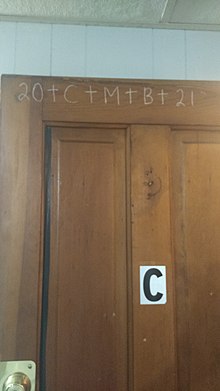Chalking the door
[1] It is normatively in the pattern of three crosses that are positioned in between the initials of the three wise men, which are surrounded by the first two and last two digits of the current year, e.g. 20 ✝ C ✝ M ✝ B ✝ 25.
[3][4] Either on Twelfth Night (5 January), the twelfth day of Christmastide and eve of the feast of the Epiphany, or on Epiphany Day (6 January) itself, many Christians (including Anglicans, Episcopalians, Lutherans, Methodists, Presbyterians and Roman Catholics, among others) write on their doors or lintels with chalk in a pattern such as "20 ✝ C ✝ M ✝ B ✝ 25".
The letters C, M, and B stand for the traditional names of the biblical Magi (Caspar, Melchior and Balthazar), or alternatively for the Latin blessing Christus mansionem benedicat ('May Christ bless this house'),[5] or IIIK referring to the three kings [citation needed].
[7] The Christian custom of chalking the door has a biblical precedent as the Israelites in the Old Testament marked their doors in order to be saved from death; likewise, the Epiphanytide practice serves to protect Christian homes from evil spirits until the next Epiphany Day, at which time the custom is repeated.
[9][a] In 20th century Poland, the practice of chalking the door continued among believers as a way of asserting their Christian identity, despite the Eastern Bloc's state atheism and anti-religious campaigns.

